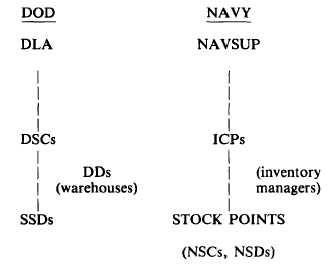| |
DD cannot accept requisitions directly or issue
stock without the prior authorization of the DSC.
The principal DDs are located in Mechanicsburg,
Pennsylvania; Memphis, Tennessee; Ogden,
Utah; and Tracy, California.
Specialized Support Depots
Because of the large number of afloat
customers, the DLA has established two SSDs to
provide direct support to the Navy. The two SSDs
are the Navy supply centers at Norfolk and
Oakland. The SSDs, unlike the DDs, have the
authority to receive requisitions directly and to
make issues locally. The inventory held at each
depot is, however, owned and managed centrally
by the cognizant DSC.
NAVY SUPPLY SYSTEM
As was mentioned at the beginning of the
chapter, the Navy supply system is integrated with
the Defense Logistics Agency system. The mis-
sion, organization, and functions of the com-
ponents of the Navy system are described below.
Like the DLA system, there are inventory
managers (the inventory control points), a
distribution system (NSCs, NSDs), and a central
headquarters (NAVSUP). The following diagram
is a comparison of the two systems:
NAVAL SUPPLY SYSTEMS
COMMAND
The Naval Supply Systems Command (NAV-
SUP) supervises the provisioning, cataloging,
inventory management, distribution, materials
handling, traffic management, transportation,
packaging, preservation, receipt, storage, issue,
and disposal of Navy supplies and material, ex-
cept for those items specifically assigned to other
systems commands or offices. Although NAV-
SUP relies heavily on the other systems commands
for technical advice concerning equipment and
material requirements, it also furnishes supply
management methods and guidance to commands
and offices that request management assistance
in supply functions.
NAVSUP is also responsible for the develop-
ment and supervision of the Navy supply system.
It must combine all supply and distribution func-
tions into one system so that the system can meet
the objective of responsive and efficient material
support to the operating forces. This is not a
simple task. The Navy supply system must be
responsive to all levels of command and must
operate at all levels. It is not enough to develop
only those capabilities that will enable a supply
system to meet the needs of one ship, one task
force, or one fleet. The Navy supply system must
be able to respond to all the needs of the operating
forces and of their related support activities.
As you read the following sections, you should
recognize how many supply functions are inter-
related so that the Navy supply system can sup-
port your ship or any other component of the
operating forces. You should also determine how
your supply department, afloat or ashore, func-
tions in much the same way in meeting the needs
of a ship or a station. The basic elements of supply
support, for one ship or for the entire Navy,
involve the determination of requirements, pro-
curement, and distribution.
Determination of Requirements
Determining requirements for material should
not be new to you as you have probably already
had some experience in this area aboard your ship.
In performing this job, you have had two excellent
tools to work with—the Coordinated Shipboard
Allowance List (COSAL) and the usage data from
your stock record cards. The COSAL is discussed
later in this rate training manual and in Military
Requirements for Petty Officer Third Class
through Chief Petty Officer. The Navy supply
system uses the COSAL and stock record cards
for determining the requirements for replenish-
ment materials. However, not all material comes
under the heading of replenishment. When new
material, such as the repair parts requirement
for a newly developed item of equipment, is
2-3
|

